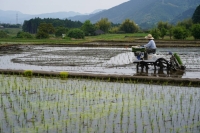Japan's food self-sufficiency rate on a caloric intake basis stood at 38% in the fiscal year from April 2022, unchanged from the previous year and still near a record low, the farm ministry said Monday, adding pressure on the country to enhance food security.
When measured by production value, the rate was 58%, down 5 percentage points from fiscal 2021, the lowest among comparable data available since 1965, as an increase in global grain prices and the yen's downtrend have raised the value of imports, the ministry said.
The dwindling rate on a caloric-intake basis, which is one of the lowest among major economies, underscores the struggle the government faces to reach 45% by fiscal 2030 amid Russia's invasion of Ukraine, a major producer of grains.
On a production-value basis, the government targets 75% by fiscal 2030.
The rate of 38% for fiscal 2022 on caloric-intake basis remains close to a record low of 37%, which was most recently logged in fiscal 2020.
For fiscal 2022, not only did the number of shellfish and fish caught and the amount of wheat harvested decrease, but the consumption of oils and fats, which Japan largely imports, also fell, resulting in the same rate as the previous year, the ministry said.
The decadeslong downward trend in the self-sufficiency rate reflects changes in the Japanese diet, with the consumption of domestic rice on the decline and that of meat on the rise.
By food items, the self-sufficiency rate, on a weight basis, for rice rose 1 percentage point to 99%, while wheat fell 2 points to 15%, and soybeans 1 point to 6%.
The rate for vegetables was 79%, a decrease of 1 point, while shellfish and sea fish fell 4 points to 54%.




